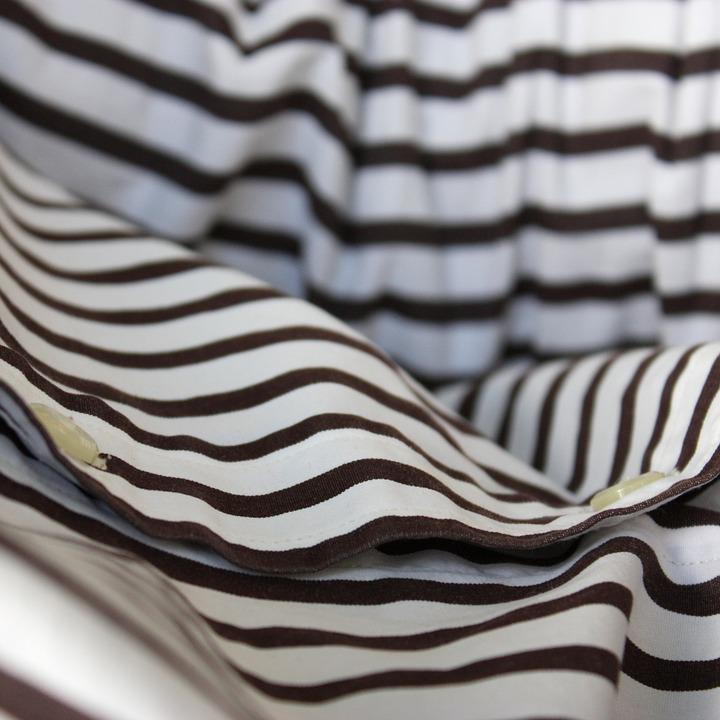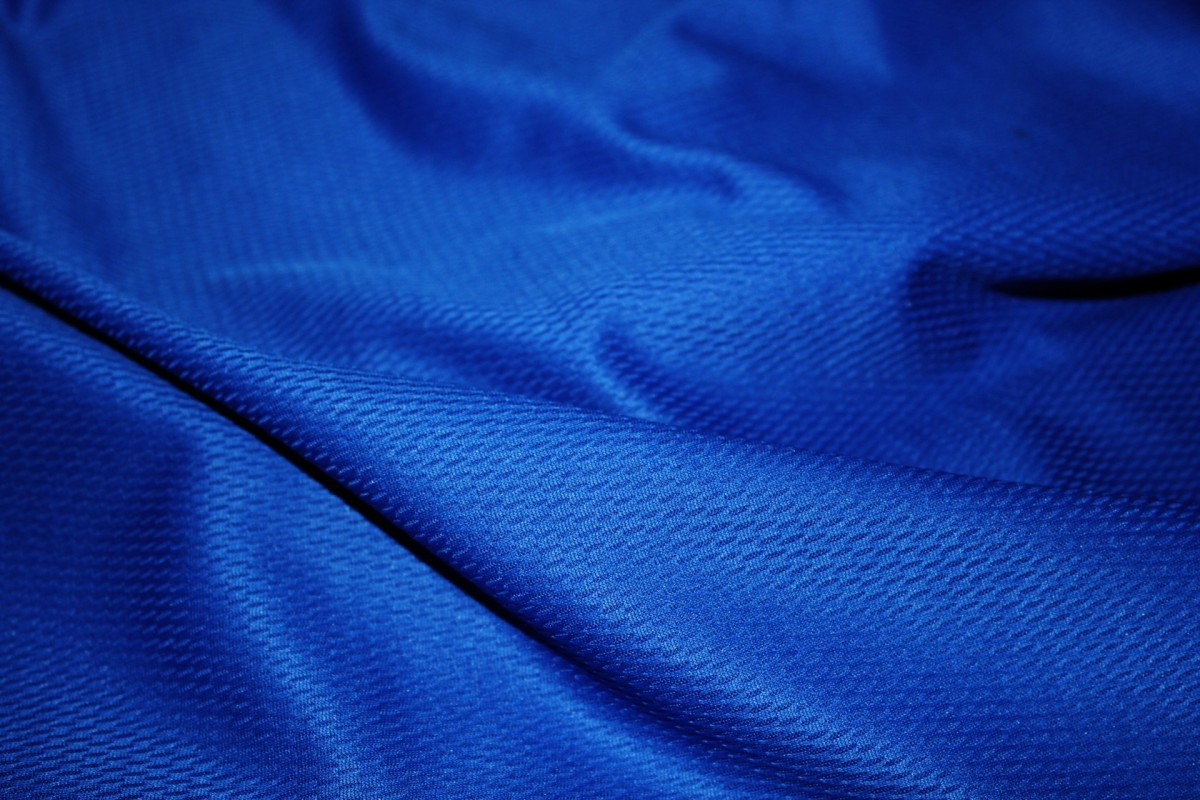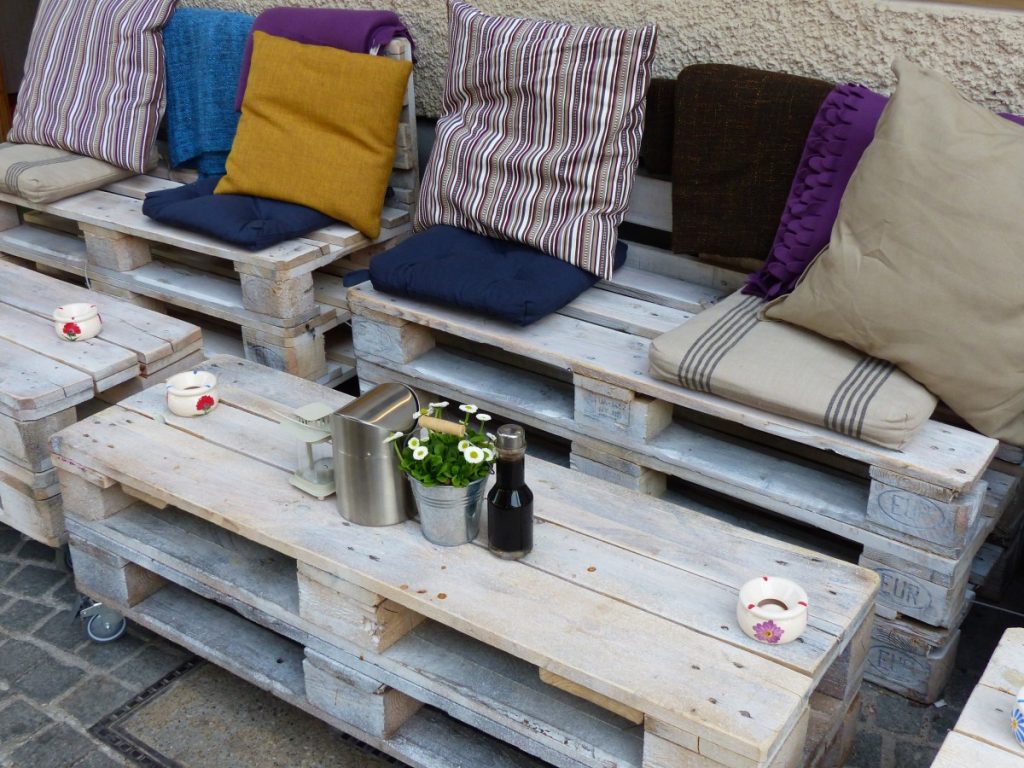
How to Sew Jersey
Solving possible problems in sewing stockinette
Jersey is a very finely knitted fabric. Soft and naturally stretchy due to its manufacturing process, it is pleasant to wear and is mainly used for T-shirts, underwear, sportswear… Sewing jerseys is not tricky, but you must take some precautions because knitted textiles are not worked the same way as woven textiles.
Focus on the types of jersey

Jersey is the name of the manufacturing process of the textile. A piece of jersey fabric is a fabric knitted with a jersey stitch. You can recognize it easily:
On the right side, the stitches are in the shape of V’s interlocked with each other.
On the reverse side, the stitches look like bridges that overlap.
A jersey fabric can be made of cotton, viscose, polyester… It is naturally stretchy, but sometimes elastane, or another elastic material, is added to make it even more stretchy.
Jersey also comes in different thicknesses: it can be very thin for light, flowing garments (like a dress) or thicker for warm garments (like jogging pants).
Viscose jersey
Viscose jersey is thin and fluid. The colors are very deep and resist washing very well. Because of its thinness and flexibility can be more difficult to work with because it slips easily, and the edges roll after being cut. It is ideal for women’s clothing such as dresses, draped tops…
Cotton jersey
100% cotton jersey is the fabric used for T-shirts.
It comes in different thicknesses, in all colors, plain, printed, and even in organic cotton. It is slightly stretchy and very comfortable.
It is used for casual clothing that does not require much stretch or children’s clothing because it is made of natural material and is soft to wear.
It is also straightforward to care for, as cotton can be washed at high temperatures. It is best for beginners as it is easier to sew.
Cotton/elastane jersey
Cotton/elastane jersey is also very comfortable to wear and, because of its elasticity, is mainly used for sportswear, tight-fitting garments such as leggings, or even underwear.
It is similar in appearance to 100% cotton jersey but more elastic because it contains elastane in varying proportions. The higher the elastane content, the more flexible the fabric.
It also comes in different thicknesses.
It is easy to care for but cannot be washed at very high temperatures because the elastic fibers are damaged by heat.
Synthetic jersey
Synthetic jersey (polyester, polyamide…) is mainly used for sportswear and technical clothing because it dries quickly and is easy to care for.
Sequined, shiny, and masquerade costume jerseys are also made of synthetic materials. Finally, polyamide or nylon jersey is used to make swimwear.
Fleece
The fleece is a jersey of cotton or cotton mixed with synthetic fibers, very thick and warm.
It is made with thicker yarns and is often “scraped” on the back, making it very soft against the skin.
It is used to make sports pants, sweatshirts…
It is easy to sew because it has little stretch and does not slip.
Milano Jersey
Milano jersey is a thick jersey, less flexible than a cotton jersey. It is used for women’s clothing that does not need to be too soft, such as sweaters, straight skirts, jackets …
Wool jersey
A wool jersey is used for some suits, suits, coats, or dressy clothes. It is not very common nowadays, because it is difficult to maintain: hand wash or dry clean only. It is also more expensive and is often replaced by synthetic jerseys.
Bamboo jersey
The bamboo jersey is often made from organic bamboo, which is quite similar to the cotton jersey. It is also very soft, healthy, and comfortable to wear.
Ribbed jersey
Ribbed jersey can be made of cotton, polyamide, with elastane… It is a classic jersey but made in a tube shape. It is used to make cuffs or collars for sweaters and dresses easily. It is medium to thick.
1. Choose your jersey
Jersey is chosen according to the type of garment you want to make.
Read more: How to Knit in Jersey
To sew a dress, skirt, flowing women’s top, or summer clothing:
- viscose jersey;
- fine cotton jersey;
- fine bamboo jersey.
To sew children’s clothing:
- medium weight cotton jersey;
- thin to medium cotton/elastane jersey;
- fleece jersey;
- organic cotton jersey;
Bamboo jersey
For sewing suits, jackets, and dress clothes:
- wool jersey;
- Milano jersey.
For close-fitting sewing garments: tops, leggings, panties…
cotton/elastane jersey of fine to medium thickness;
synthetic / polyester/polyamide jersey, thin to medium consistency.
For sewing sportswear and technical clothing:
- cotton/elastane jersey;
- synthetic jersey;
- fleece jersey.
For casual sewing clothing: t-shirts, sweatshirts…
cotton jersey, from thin to thick;
cotton/elastane jersey;
fleece jersey.
For sewing costumes:
- viscose jersey;
- synthetic jersey.
Which jersey to choose when you are a beginner in sewing?
When you are a beginner in sewing, it is preferable to choose a jersey that is easy to work with and does not slip:
cotton jersey, medium to thick thickness;
cotton/elastane jersey, medium to thick;
- fleece jersey;
- wool jersey;
- Milano jersey.
2. Prepare the jersey
Before starting to sew the jersey, you should take a few precautions to ensure the garment is well made.
Wash the jersey
Like all elastic fabrics, jersey tends to shrink in the first wash. To avoid ending up with a too-small garment, start by washing your stockinette in the machine before cutting it.
Use a pattern for stretchy fabrics
Because a jersey is stretchy, the pattern for a jersey garment is different from a woven garment. For jerseys, the pattern will be more fitted, with wider curves.
If you want to sew a jersey garment, make sure your pattern is made for sewing jerseys.
Use a pattern for woven fabrics. Your garment will be too wide, will not fall properly, or you will not be able to put it on at all: jersey garments have few means of opening/closing (zippers, buttonholes…) because they are stretchy enough to be put on without having to open/close them.
Locate the direction of the jersey
When you want to sew stockinette, make sure you cut your pieces in the right direction: the lines formed by the stitches on the right side of the fabric should be parallel to the selvage, which is the edge of the fabric. You can also check the direction of the fabric by stretching it: the most elastic direction is the width of the fabric. Jersey is stretchy in its width but very little, if any, in its height.
Lay out the pattern pieces on your stockinette fabric so that the straight thread (fabric direction) shown on the pattern is parallel to the selvage and, therefore, to the lines formed by the stitches on the right side of the fabric.
Iron the stockinette
As with all fabrics, stockinette must be ironed before cutting. When ironing, only iron one layer of fabric at a time: if you fold the stockinette in half to iron faster because it is an elastic fabric, the fabric underneath will shift and wrinkle when ironed.
Pin the stockinette
When you pin your pattern to a stockinette, it tends to stretch. If it stretches too much when you unpin your pattern, the fabric will return to its original position, and the lines you drew when the fabric is stretched will be wrong.
To pin stockinette without stretching it:
Use extra fine pins.
Pin the fabric slowly to minimize movement.
Trace on stockinette
As with pinning, tracing can stretch the fabric, distorting your lines. To trace on stockinette without stretching it, choose a tailor’s chalk or a special soft fabric marker: you don’t need to put much pressure on the chalk, or the lead of the marker, to draw your lines.
Roller chalks, also known as Japanese chalks, are especially good for stockinette, as the small teeth of the roller grip the fabric without stretching it, and deposit powdered chalk on the fabric without pressing it hard on the roller.
Cutting stockinette
When cutting stockinette fabric:
Use sharp sewing scissors: if the blade is dull, the fabric fibers will catch on the irregularities of the blade and stretch the fabric.
Cut your fabric slowly so that it doesn’t move or slip.
If you plan to sew stockinette regularly, you may want to invest in a rotary cutter: they are convenient for cutting stockinette and slippery materials.
3. Sewing jersey
For sewing stockinette, the best way is to use a serger, which produces an elastic stitch while overlocking and trimming the edges of the fabric. But you can also sew stockinette on a sewing machine.
Choose the right needle
Choose the type of needle:
Sew with a special jersey, stretch, or super stretch sewing machine needle. These needles have a rounded tip, which allows them to slip between the stitches without damaging them. If you use a conventional needle, the stitches along the seam may come undone by the needle, and stitches will be skipped when sewing.
Depending on the brand, the needle heel is sometimes painted yellow, red, or both, so you can easily recognize stretch needles.
Choose the needle size. Knowing what size to use is very simple: the thinner your jersey, the finer the needle.
For viscose jerseys, for example, use a needle with a thickness between 60 and 80.
For medium fabrics, use an 80 to 90 needle.
And for thick fabrics, choose a needle size of 90 or larger.
Choose the stitch
If your sewing machine has an elastic stitch, sew your stockinette with that stitch.
If not, a zigzag stitch will also work well. Because the zigzag stitch is elastic, the seam will follow the movement when the stockinette is stretched.
If you sew with a straight stitch, the seam will break as soon as the fabric is stretched.
Choose the thread
For sewing stockinette, choose synthetic fiber threads (polyester, nylon), which are more elastic than cotton threads and finer. You can also use foam thread in bobbin thread, which is very elastic and specially designed for elastic seams. Foam thread is especially recommended for underwear and close-fitting garments because it is very soft.
Avoid poor quality threads: if the thread is badly woven, its tension will be uneven, and so will the seam, which is particularly noticeable on a jersey.
Training the fabric
As you sew, let the fabric slide under the sewing machine’s presser foot without pulling it toward you or behind the presser foot so that the seam doesn’t curl when finished.
You can use a carrier foot, which is designed to help feed thick or stretchy fabrics, by pulling the fabric over the top.
If you want your seam bulge to make a rolled or wavy hem, set your machine to a tight zigzag stitch or overlock stitch. When you sew the edge of the fabric, do the opposite of a conventional seam: stretch the fabric as much as possible.
Tip: If the sewing machine does not properly drive your jersey fabric, you can stabilize it by placing a sheet of tissue paper on top of the fabric, which you will tear off once your seam is complete.
Sewing jersey with a non-elastic fabric
Use a stretch or stockinette needle.
Sew with a straight stitch.
When machine sewing, if possible, put the non-elastic fabric on top and the stockinette fabric on the bottom (against the feed dogs).
Stiffening a seam in stockinette
If you want to stiffen a seam in a jersey garment, such as a shoulder seam that will be cleaner if it is not elastic:
Position the two pieces of jersey fabric to be sewn right sides together.
Place a twill tape (stiff cotton tape) or a non-elastic strip of fabric that you have cut out on the top of your fabric (i.e., on the back of the fabric) where you will be sewing.
Use unfolded bias tape if your seam is rounded (armholes, collars…).
Sew your fabric layers together, with the stabilizer fabric (non-elastic) on top, in a straight stitch.
Turn over and press your seam: it is now non-elastic and will stay in place.
You can also use a strip of thin iron-on fabric or cut the edge of a piece of non-elastic fabric.
Topstitching on stockinette
A topstitch is a decorative or fastening seam. It is visible on the right side of the garment and follows the outline of collars, cuffs… A topstitch is made with a straight stitch, which is not elastic. Seams on jersey fabrics must be elastic. To topstitch jersey, use a double needle:
The twin needle allows you to have two straight stitch seams on the right side and a zigzag on the wrong side, making the seam elastic. Twin needles are available in two widths (distance between the two needles):
Double needles with 2.5 mm width are used for fine seams, on underwear, for example.
The 4 mm wide needles are ideal for topstitching T-shirt collars, for hems…
To sew a jersey with a twin needle:
Use a special jersey or stretch double needle.
Set your sewing machine to a straight stitch.
Thread two bobbins of the same color on top of the machine.
If you only have one spool of thread of the same color, use a can that you have threaded in the correct color beforehand.
Thread the top two threads as if you had only one line.
Thread the top two threads through the twin needle.
Stitch slowly.
The twin needle also allows for neat, springy hems.
Solving potential problems with stockinette sewing
If your seam curls
If possible, on your machine, decrease the tension on the presser foot or presser foot.
Decrease the tension of the top thread.
Try a different thread composition.
Install a conveyor foot on the sewing machine.
Sewing skips stitches
Check that you have installed a special stretch or stockinette needle.
Check that your needle is not dull or bent.
Change the thread: poor quality thread can skip stitches.
Install a thinner needle.
The seam is bulging
Reduce the tension of the upper thread.
Try a different thread composition.
The machine and slides swallow machine treads on the seam start or fabric into the needle plate opening.
Stabilize the stockinette by slipping a sheet of tissue paper UNDER the fabric: the paper should extend beyond the edge of the fabric.
Stitch your first stitches into the paper.
Tear off the paper when your stitching is complete.
Materials needed to sew stockinette
Sewing scissors
Chalk
Iron
Sewing thread
Sewing machine



